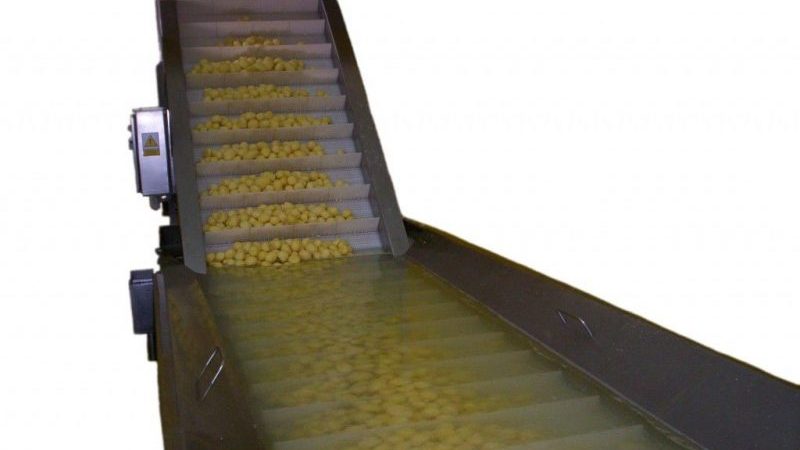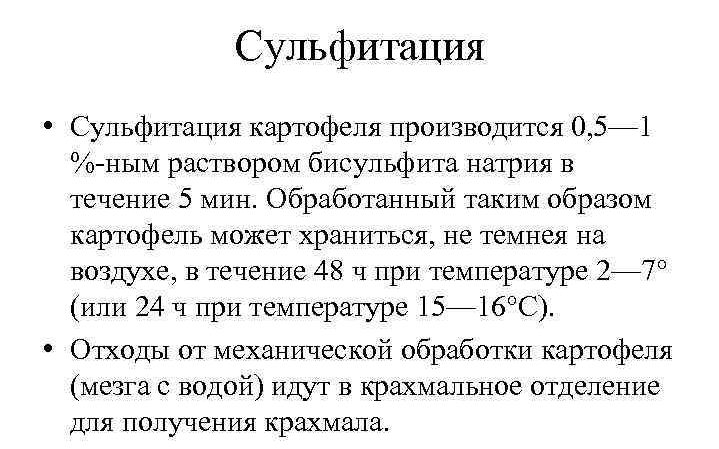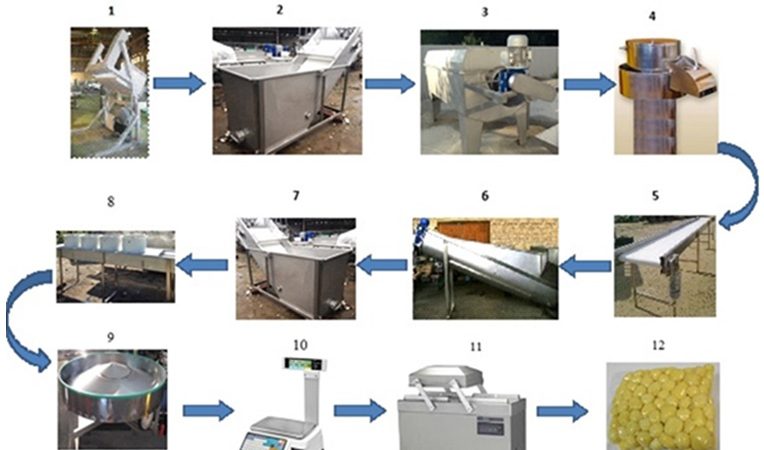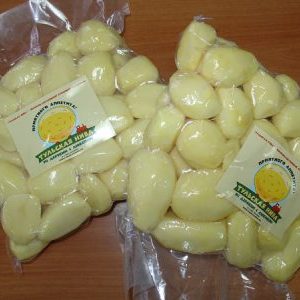What is potato sulfitation and what is it for
Sulphitation is a technological treatment of purified potatoes special chemical solution. It is carried out to prevent darkening of tubers, eliminate harmful microorganisms, and increase the shelf life of the product. Such a semi-finished product is transported over long distances and used in cooking.
The content of the article
Potato sulfitation: simple about the complex

Peeled and cut potatoes are not subject to long-term storage, as upon contact with oxygen they darken and become unusable. This happens due to the oxidation reaction: hydrogen leaves the tubers, oxygen is absorbed into the pulp. Although only the surface darkens, the quality of vegetables is seriously altered: their nutritional value decreases, and the taste is lost.
To maintain their natural color, benefits and quality, the tubers are treated with a solution of sulfurous acid. The scientific name for the procedure is sulphitation.
What is it for
Usually, peeled tubers are stored in water to prevent browning, but this method has disadvantages:
- significant loss of nutrient dry matter;
- deactivation;
- impossibility of long-term storage.
The alternative to this is sulfitation. Sulfurous acid not only protects potatoes from browning, but also has antiseptic properties - it kills putrefactive bacteria and fungi. The protective film formed on the surface helps to preserve the taste and beneficial properties of the vegetable.
Attention! After processing, potatoes are stored without darkening for up to 2 days. This allows you to transport it to any distance.
The essence and characteristics of sulfitation

How and why are potatoes sulfided? The cleaned tubers are treated with an aqueous solution of sodium salts of sulfurous acid. As a result of their decomposition, sulfur dioxide (SO2) is formed. It inhibits the activity of the enzyme polyphenol oxidase, which delays the formation of melanins - pigments that cause darkening of vegetables.
Sulfurous anhydride is hazardous to health. Its permissible content in vegetables is not more than 0.02%. Immediately after sulfitation, this figure exceeds the norm by 10-15 times. Therefore, before evacuation, the potatoes are washed several times in clean water. Desulfation is carried out before use - removal of a chemical compound by heating. As a result, SO2 escapes with water vapor.
By the way! Many are interested in what it is - raw peeled sulfite potatoes. This is a semi-finished product for further industrial processing and use for culinary purposes.
How sulfitation occurs
Processing is carried out at large enterprises in the course of procurement work. The crop is sulfitized immediately after harvest.

Training
This is the first important step. Not all tubers are suitable for further processing. Characteristics of suitable vegetables:
- round or oval-round shape;
- the surface is smooth, without growths;
- the peel is thin;
- a small number of eyes are allowed, their maximum diameter is 5 mm.
Do not use defective potatoes with signs of disease or pests, frostbitten, lethargic, sprouted, small, mechanically damaged or rotten tubers.
Preliminary preparation begins with washing the potatoes. The tubers are thoroughly cleaned of dirt, the peel is cut off with a thin layer.During inspection and cleaning, the remnants of the skin and eyes are removed, the vegetables are washed and kept in clean water until they are dipped into the working solution.
Reference. Whole and cut tubers are sulfitized. Various forms of cutting are allowed: straws, slices, cubes, circles.
What solutions are used
Use bisulfite or sodium hydrogen sulfite. Chemical formula - NaHSO3. Produced in pure form. Sometimes sodium pyrosulfite (Na2S2O5) is used - a white crystalline powder, similar to baking soda, which, when decomposed in water, converts to bisulfite.
To prepare the working solution, take containers from any non-corrosive material. The best option is stainless steel or food grade plastic. Galvanized steel is not suitable. For every 10 liters of water, take 4 g of bisulfite or pyrosulfite. The finished concentrate is reused up to 10-12 times.
Step by step description

Sulphitation is carried out on professional equipment in the workshops of the enterprise. Processing consists of several stages:
- Peeled potatoes are kept in trays or barrels of water to prevent browning.
- From the container, the tubers are selected in duralumin nets.
- After the water is completely drained, the vegetables are treated with sodium bisulfite solution for 5 minutes.
- The mesh is removed, the liquid is allowed to drain.
- The tubers are washed in cold water. The ratio of potatoes: water is 1: 2. Perform 2-3 full immersions.
The finished sulfided vegetables are placed in containers, baskets or plastic bags. The potatoes are vacuum packed, labeled, stored or sent for sale.
Read also:
How to get rid of mice and rats that gnaw potatoes in the cellar.
Advantages and disadvantages
Processing has strengths and weaknesses. Benefits for manufacturers:
- the fastest possible processing of raw materials with low labor costs;
- possibility of transportation over long distances;
- preservation of the presentation;
- increased shelf life.
The advantage for consumers is convenience and significant time savings. However, the quality of such potatoes is low; in terms of properties and benefits, it loses to fresh ones. Sulfite tubers are used to make chips and other similar dishes. Sulfurous anhydride is completely absent in dried vegetables.
Important! The disadvantage of the procedure is the toxicity of the working solution. Although potatoes are soaked and washed and then cooked, a low concentration of bisulfite remains in the tubers.
Is such a potato harmful?

According to sanitary standards, sulfite potatoes cannot be used in the production of infant formula, dietary food, and canned food. Anhydride-treated tubers are prohibited in childhood.
Eating these vegetables infrequently does not harm the body. If you use a semi-finished product regularly and in large quantities, allergic reactions, digestive problems, vitamin B1 is washed out. Bisulfite accumulates in the body as a carcinogen.
Conclusion
Sulphitation is a method of technological processing of vegetables for industrial purposes at large procurement enterprises. It preserves the presentation of peeled potatoes and prevents oxidation and browning processes.
The treatment is carried out with a working solution of sodium bisulfite (a derivative of sulfurous acid). The substance has an antiseptic effect on tubers, inhibits the viability of microorganisms, increasing the shelf life of the product. Peeled tubers are stored outdoors from 6-8 hours to 2 days.